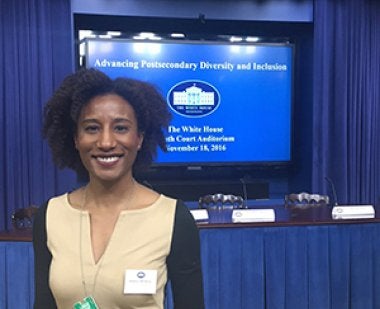
COLLEGE PARK, MD (December, 2016) – During a Nov. 18 White House summit, Kimberly Griffin, an associate professor in the College of Education’s Counseling, Higher Education, and Special Education Department, discussed faculty diversity in higher education and how it relates to student learning and success.
The panel, “Research-Based Practices and Strategies,” was part of the White House Summit on Advancing Post Secondary Diversity and Inclusion to Expand College Opportunity and explored how data can be used to promote diversity and inclusive campus climates.
While the impact of a diverse student body has been analyzed extensively, less work has been done to study diversity in faculty, said Griffin, who is part of CHSE’s Higher Education, Student Affairs, and International Education program.
According to Griffin, “Faculty members of color make several unique contributions to college and university campuses.” Research suggests they are more likely to couple moral and emotional development with an emphasis content knowledge when teaching; expose students to diverse perspectives; and provide guidance and support to students of color, she said. “Increasing faculty diversity is consistently on student protesters’ lists of demands because these professors have traditionally offered unique support and guidance to underrepresented students.”
While some progress has been made on the diversity front, individuals from underrepresented groups still only make up about 11 percent of all professors, and are less likely to be tenured or full professors, according to Dr. Griffin.
Some attribute the lack of faculty diversity to the “pipeline problem,” suggesting that there aren’t enough students in undergraduate and graduate programs to enter faculty positions. Others argue implicit bias and other issues in the hiring process that work against potential candidates.
Dr. Griffin, however, believes there are additional factors to consider: who is admitted into top graduate programs that are well-known for preparing faculty members, whether all doctorate students aspire to become professors, and retaining scholars of color once they are hired for faculty positions.
To be successful, the issue must be tackled on the individual level and institution-wide, Dr. Griffin said. She suggested careful examination of admissions policies and whether elements like the GRE predict success; more attention to career development in graduate programs; and changes in hiring policies and processes that include implicit bias training, as well how candidates contribute to diversity and inclusion with their teaching, research, and service.
The panel took place the same day the U.S. Department of Education released its “Advancing Diversity and Inclusion in Higher Education” report, which includes information about inequalities and opportunity gaps for students of color and low-income students, as well as college programs providing opportunities for all students.


